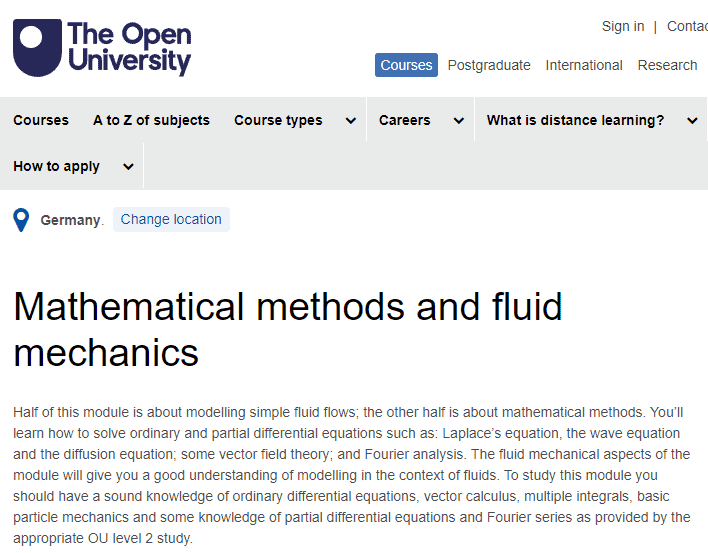物理代写|ME3103 Fluid Mechanics
Statistics-lab™可以为您提供ac.uk ME3103 Fluid Mechanics流体力学课程的代写代考和辅导服务!

ME3103 Fluid Mechanics课程简介
Physical properties of fluids:
Fluids are substances that can flow and take the shape of the container they occupy. The physical properties of fluids include density, viscosity, surface tension, and compressibility.
Density is defined as the mass per unit volume of a fluid. It is denoted by the symbol ρ and is measured in kg/m³.
Viscosity is a measure of a fluid’s resistance to deformation or flow. It is denoted by the symbol μ and is measured in Pa·s or N·s/m².
Surface tension is the force per unit length acting perpendicular to any line drawn on the surface of a liquid. It is denoted by the symbol γ and is measured in N/m.
Compressibility is a measure of how much a fluid’s volume changes when subjected to a pressure change. It is denoted by the symbol β and is measured in 1/Pa.
PREREQUISITES
Outcome 1: Students will be able to use the fundamental principles and mathematical basis underlying the conservation equations.
Outcome 2: Be able to identify the guiding principles in a given fluid problem, to formulate the governing equations, and so to solve basic engineering problems.
Outcome 3: Recognize the difference between an ideal fluid and a viscous fluid, and to understand the limitations of the solutions for real practical fluid flows. Understand the difference between a simple solution and a real practical problem.
Outcome 4: Understand where their analysis might involve approximations and empirical approaches; for example, pipe flows and boundary layer flows.
Outcome 5: Have improved their ability to formulate an ordered approach to problem solving, using words of explanation in derivations, and algebra before substituting numerical values that allows neat analytical solutions and dimensional analysis.
ME3103 Fluid Mechanics HELP(EXAM HELP, ONLINE TUTOR)
Problem 3.1 The material description of a fluid motion is given by the pathline equations
$$
\begin{aligned}
& x_1=\xi_1, \
& x_2=k \xi_1^2 t^2+\xi_2, \
& x_3=\xi_3
\end{aligned}
$$
with $k$ as a constant having a dimension, such that the dimensional integrity of both sides of the above equation systems is preserved. Show that the Jacobian determinant $J=\operatorname{det}\left(\partial x_i / \partial \xi_j\right)$ does not vanish and obtain the transformation $\boldsymbol{\xi}=\boldsymbol{\xi}(x, t)$.
Problem 3.2 The fluid motion is described by:
$$
\begin{aligned}
x_1 & =\xi_1, \
x_2 & =\frac{1}{2}\left(\xi_2+\xi_3\right) e^{a t}+\frac{1}{2}\left(\xi_2-\xi_3\right) e^{-a t}, \
x_3 & =\frac{1}{2}\left(\xi_2+\xi_3\right) e^{a t}-\frac{1}{2}\left(\xi_2-\xi_3\right) e^{-a t}
\end{aligned}
$$
(a) Show that the Jacobian determinant does not vanish.
(b) Determine the velocity and acceleration components
(1) in material coordinates $V_i\left(\xi_j, t\right), A_i\left(\xi_j, t\right)$,
(2) in spatial coordinates $V_i\left(x_j, t\right), A_i\left(x_j, t\right)$.
Problem 3.4 The motion of a fluid is described in the material coordinate by:
$$
\begin{aligned}
& x_1=\xi_1 e^{a t}, \
& x_2=\xi_2 e^{a t}, \
& x_3=\xi_3 e^{-2 a t}
\end{aligned}
$$
with $a=$ const. and $\boldsymbol{\xi}=\boldsymbol{\xi}(x, t=0)$.
a) Calculate the velocity and acceleration components $V_i\left(\xi_j, t\right.$ and $A_i\left(\xi_j, t\right)$ in material coordinates.
b) Determine the spatial description of the velocity and acceleration components $V_i\left(x_k, t\right)$ and $A_i\left(x_k, t\right)$ by eliminating the material coordinate $\xi_j=\xi_j\left(x_k, t\right)$ in the results obtained in (a).
c) Find the acceleration components using the substantial derivatives of $V_i\left(x_k, t\right)$.
d) Is this a potential flow? If yes, find the potential function.
Problem 3.7 The components of a velocity flow field $V_i\left(\xi_j\right)$ are given by
$$
\begin{aligned}
& V_1=a\left(x_1+x_2\right) \
& V_2=a\left(x_1-x_2\right) \
& V_3=W
\end{aligned}
$$
with the constants $a$ and $W$. Determine
(a) the divergence $\nabla \cdot V$ of the flow field,
(b) the rotation $\nabla \times \mathbf{V}$,
(c) the parametric representation of the pathlines $x_i=x_i\left(\xi_j, t\right)$ with $\xi_j=x_j(t=0)$,
(d) nonparametric representation of the projection of the pathlines in $x_1, x_2$-plane by eliminating the curve parameter $t$,
(e) the projection of the streamlines in $x_1, x_2$-plane by integrating the differential equations for the streamlines.
Textbooks
• An Introduction to Stochastic Modeling, Fourth Edition by Pinsky and Karlin (freely
available through the university library here)
• Essentials of Stochastic Processes, Third Edition by Durrett (freely available through
the university library here)
To reiterate, the textbooks are freely available through the university library. Note that
you must be connected to the university Wi-Fi or VPN to access the ebooks from the library
links. Furthermore, the library links take some time to populate, so do not be alarmed if
the webpage looks bare for a few seconds.

Statistics-lab™可以为您提供ac.uk ME3103 Fluid Mechanics流体力学课程的代写代考和辅导服务! 请认准Statistics-lab™. Statistics-lab™为您的留学生涯保驾护航。